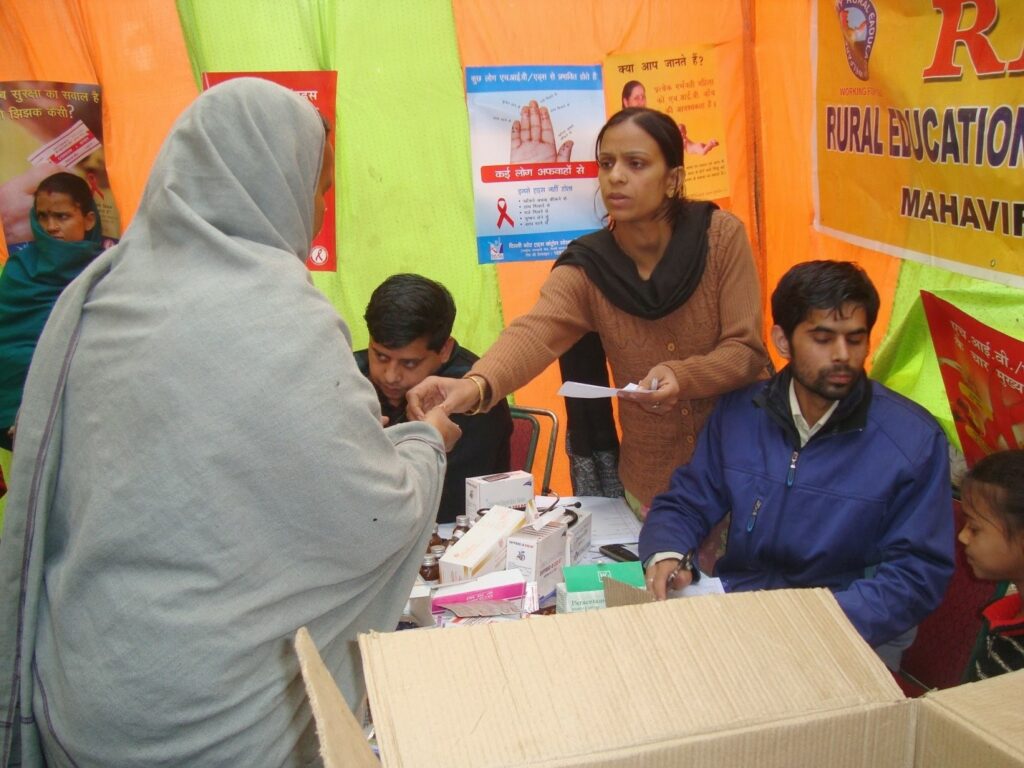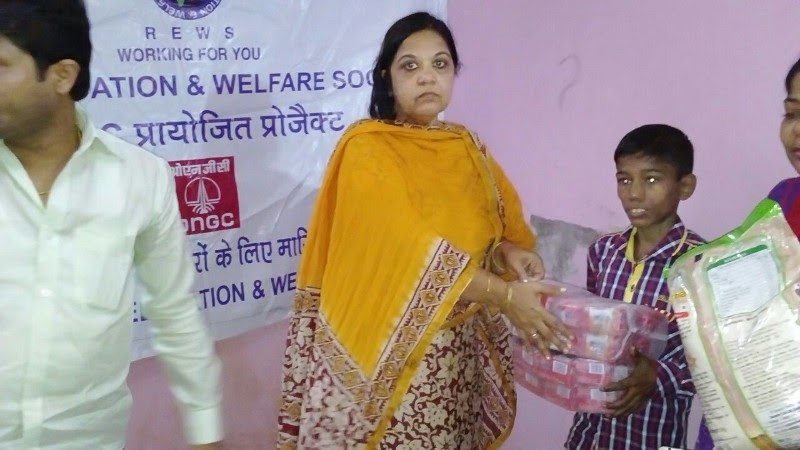Adolescent Health
The stage of adolescence increases vulnerability, all the more, as it the juncture of life which may be described as “a phase that begins in biology and ends in society”. Adolescents stand at the crossroads between childhood and the adult world. Around 243 million adolescents (21% of Indian population) live in India.
As they stand at these crossroads, so do societies at large – the crossroads between losing out on the potential of a generation or nurturing them to transform society. It is indeed an age of opportunity.
With such thought process, REWS focuses on adolescence issues- health, sex education and responsible adulthood, vocational skill training, career prospects and counseling.
However, with growing demographics, rapid industrialization and modernizations in India, has also brought in spate of vehicles on road and consequently casualties due to accidents and fatalities both on city roads and highways. Adolescents and youths are majorly and evidently both -cause and victims of road accidents.
As a step ahead, REWS has added a new vertical in its program portfolio- comprehensive action oriented awareness, education and counseling on road safety.
Road Safety- advocacy program
Concerned towards the increased number of road accidents at the state and national highways across the state, the state government of Rajasthan (one of the top States in India attracting global tourists) has come up with a joint campaign ‘Sadak Suraksha Jagran Abhiyan”. The objective of the campaign on Road Safety is to reduce the rate of accidents, injury and death associated with road transport through advocacy program.
Road Safety Awareness Project funded by the World Bank/Govt. of Rajasthan covered in all 8 districts in Ajmer and Bharatpur. In Ajmer zone, the districts covered has been Ajmer, Tonk, Bhilwara and Nagaur and in Bharatpur Zone it covered Dholpur,Karauli, Sawaimadhepur and Bharatpur.
Project duration was from 16 April 2016 to 31st December 2018. Road Safety Awareness and BLS (Basic Life Support) training was given to 10 volunteers at each gram panchayat of 8 districts to reduce accident and fatalities (deaths); and practice of carrying the patient from accident spot to hospital for emergency medical service .
The training was conducted with help of audio-visuals such as amplifier, speaker, LCD projector and IEC kits like posters , backdrop standees and banners in and around the venue.
Broad objective of the project
Bring down the number of fatalities and injuries due to road traffic crashes by creating sustainable road safety awareness and education programs to targeted road user groups of the rural and semi-urban population.
Objectives in specific have been as follows:
o Sensitization of community to road safety & a sense of ownership;
o Imparting Knowledge and Education
o Good driving practices
o First-Aid Training
Scope of Work
o Develop and disseminate information on the risks associated to road traffic, good practices in road safety among rural and semi-urban population,
o Change road safety habits/attitudes of road users to promote safe road user behavior, improve knowledge and change road safety habits/attitudes of road users,
o Develop and disseminate information on the risks associated to road traffic, good practices in road safety among rural and semi-urban population,
o Raise cadre of mentors and communicators from rural areas to spread awareness that road safety issues are a major community concern and about various aspects of road safety among rural population, actively engaging community in identifying road safety problems and solutions,
o Develop capacity and establish linkages with road safety institutions assisting communities to plan , manage and sustain their own road safety initiatives,
o Educate people about proper use of available road safety engineering facilities,
o Make drivers aware about road safety and safe driving,
o Increasing a sense of ownership of road users, particularly on pavement protection (damage from agriculture equipment etc.) and drainage issue.
The Strategic Approach
It included addressing the issues causing accidents on basis of diagnostic study which included :
o Manage speed,
o Stopping driving by impaired persons(visual, mental, alcohol-caused loss of alertness and common senses etc),
o Use of seatbelts
o Use of helmets
o Improve roadway design to tackle safety effectively
The project included a sample survey for problem identification. Sample size included: Students–20(4 in each GP), Drivers 20(4 in each GP), General Public-50(10 in each GP), Volunteers–10 (2 in each GP); Total sample being 20 from each GP or 100 at each block or 200 at each district or 800 for the zone.
The survey revealed the following which provided genesis for tailoring the intervention strategy:
o Accidents spot analysis
o Safety Record of highways and important district roads as well as other local roads through available data
On the basis of survey results, the following exercise was conducted:
o Mapping of black spots to develop patterns/correlations of locations, reasons, vulnerable groups and types of accidents;
o Evaluation of contents and impacts of previous road safety campaigns and identification of focus areas in campaign and training
Campaign activities carried out have been One Day Road Safety Awareness Program for 10 Volunteers from each Panchayat Samitis (PS) and Gram Panchayat Samitis (GPS), Training Sessions in 100 Schools, Training of 60 Truck/Bus drivers (half—day) – before taking it to general masses of GP/PS.
Training & Awareness Program covered the following stake holders:
Districts | Trainings of Drivers | Training in Schools | Awareness Programs and Training in Police Stations | Awareness Programs and Training in GPS |
|
|
|
|
|
Ajmer | 15 | 22 | 03 | 282 |
Bhilwara | 15 | 24 | 10 | 384 |
Nagaur | 15 | 34 | 06 | 467 |
Tonk | 15 | 20 | 05 | 230 |
Sub-Total | 60 | 100 | 24 | 1363 GP+ 41 PS |
Bharatpur | 15 | 25 | 10 | 374 |
Karauli | 15 | 25 | 6 | 227 |
Swaimadhepur | 15 | 25 | 6 | 200 |
Dholpur | 15 | 25 | 5 | 171 |
Total | 60 | 100 | 27 | 972+27 PS |
One Day Road Safety Awareness Program at Gram Panchayats/ Police Station was usually conducted in morning, afternoon or late evening at Atal sewa Kendra or shops or Chaupal Chauraha followed after advance publicity through loud speaker or Students Rally or Nukkad Natak. About 200+ people usually attended.
Training to Volunteers (10 to 15) of 3 hours duration included the following:
o Informing them about campaign and their expected role after training.
o Training through slide show specifically designed for volunteers.
o The topics included are major issues of road safety awareness and first aid & trauma care.
o First Aid and trauma care including CPR training through dummy
o Information about emergency numbers
Volunteers were provided with certificate and Booklets after Training Session.
Training in schools was usually held in morning or afternoon in school premises itself and/or open grounds after due publicity through students rally. Training program was AV based lecture/talk which was participatory in nature. The program included – Quiz competition, Slogan writing competition, Nukkad Natak and interestingly, debate on topic “who should be caught for accidents!”
Training for Truck/ Bus drivers was usually held in morning or pre-lunch period at Truckers Union, favorite spots for drivers for meals and rest; after duly informing head and his key aids of the union. Training methodology included AV based lecture /talk, Nukkad Natak, exhibiting movies, Debate on “Over loading” (what can be done?), BLS and First Aid.

They reside in very unhygienic situation in various JJ colonies and unauthorized colonies of South-West Delhi. Most of them married but living separately from their spouses because of the migration for earning money- visiting their native place/family after interval particularly on festive occasions
Most of them have addiction of one kind or the other -alcohol, drugs, chewing Gutka&drugs users. The habitation is the pockets of potential unsafe sex behavior which needs sustained& continuous behavioral change communication (BCC) creasing practice for safe sex
The project seeks to assesstheir knowledge and perception, identifying migration locations, providing them information about HIV/AIDS, STI, safe migration and linking this population to the public health services for Sexually Transmitted infection, Integrated Counselling & Testing Centre, Anti Retro Viral Therapy.
The services focused on prevention and treatment of Sexually Transmitted Infections (SIT) through linkages established with the existing health care system. Health camps are organized with support from local Panchayat or Youth clubs for identifying and treating STIs in the migrant community. Efforts were also made to link people below poverty level with Rashtriya Swastha Bima Yojna (RSBY). This helped migrants with financial support during emergency hospitalization.

Mobile Health Scheme supported by Delhi Health services
The project on Mobile health services was started at construction sites and JJ clusters of South-West Delhi(Bindapur, Sagarpur ,Harijan Basti B5 and Jhuggis, Janakpuri District centre) . For the purpose, an equipped mobile van was used. Mobile Team consisted of a qualified allopathic Doctor(MBBS), one pharmacist, one nurse /ANM and one dresser and one attendant. The project supported byDelhi Health services have been in operation for the period 2009 to 2014. The services, provided free of cost, mainly focused on preventive and curative treatment for common ailments/ diseases such as cough &cold, fever, dysentery/diarrhea, skin infections, minor cuts and injury etc. Cases needing specialized treatment were referred to nearby government hospitals.
The following number of people was provided free curative health services:
Diseases | Beneficiaries [Children(1-14)] | Beneficiaries [Women(15-49+)] | Beneficiaries [Men(15-49 +)] |
Cough and Cold | 80 | 105 | 50 |
Fever | 95 | 60 | 110 |
Mums | 5 |
|
|
diarrhea | 50 |
| 50 |
Food allergy | 10 |
|
|
Measles | 10 |
|
|
Gynecological problems |
| 300 |
|
Pregnancy issues |
| 500 |
|
HIV |
|
| 9 |
STI |
| 35 | 45 |
Nutrition support to HIV/AIDS families
Supported by ONGC, 45 persons from HIV/AIDS infected families were given free monthly groceries (food items) in the 2015.

